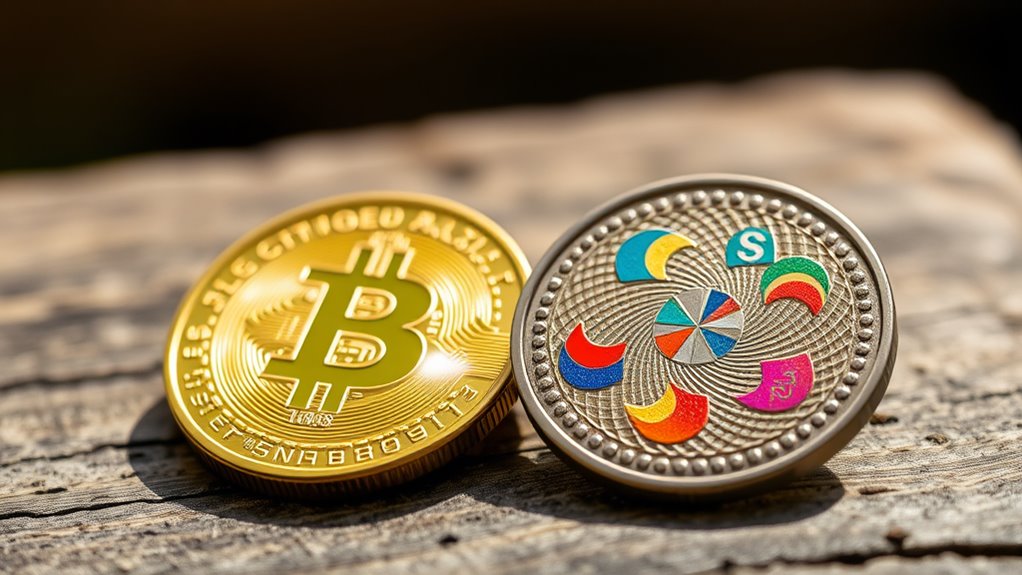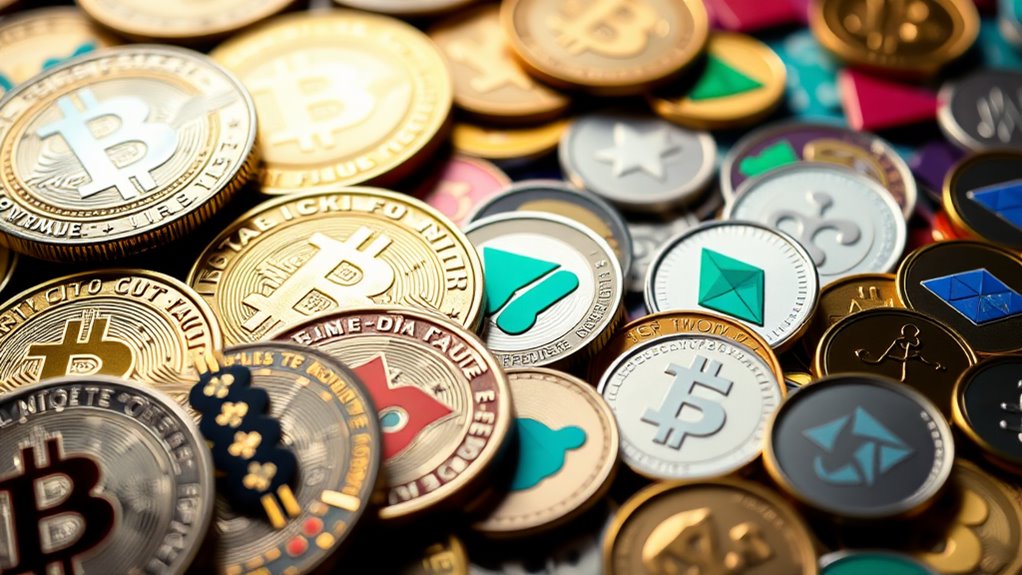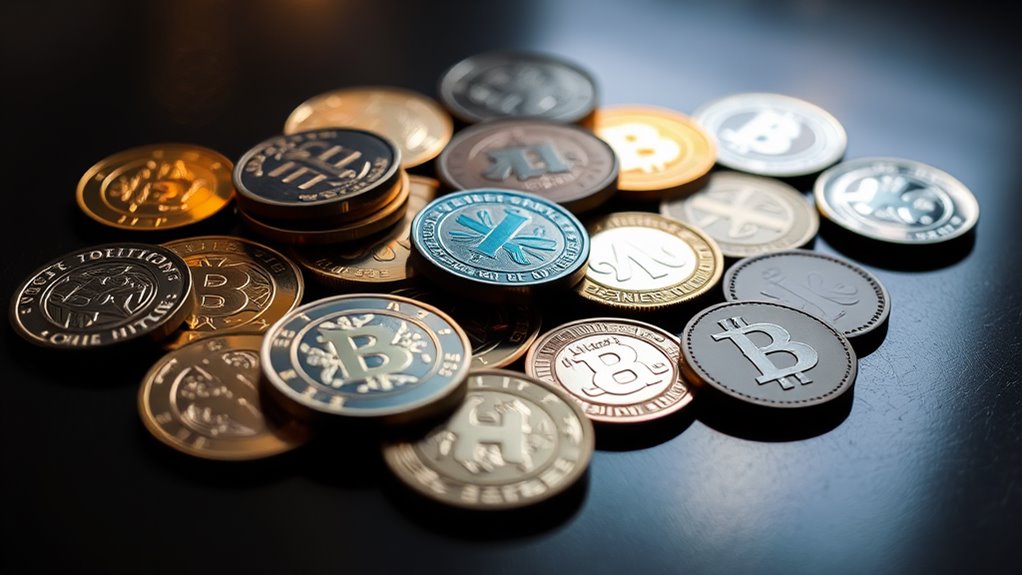
Difference Between Coins and Tokens: What Does It Mean for Cryptocurrency Users?
Coins and tokens are two main types of cryptocurrencies, serving different purposes. Coins, like Bitcoin, operate on their own blockchains and function primarily as digital money. In contrast, tokens exist on existing blockchains, utilizing smart contracts for varied applications. While coins provide security through independent networks, tokens depend on their host blockchains, which can impact their safety. Understanding these distinctions can guide users in making informed decisions about their digital asset investments. Further details on their implications can be explored.
Key Takeaways
- Coins operate on their own blockchains and serve primarily as digital currency, while tokens exist on existing blockchains for diverse functionalities.
- Coins require a higher technical barrier and resources to create, whereas tokens can be quickly developed on established platforms, reducing complexity.
- Users of coins mainly focus on transactional purposes, while token holders may also participate in governance and access decentralized applications.
- The supply dynamics of coins often feature fixed maximums, promoting scarcity, while tokens can have variable supply rules leading to price volatility.
- Understanding the distinctions between coins and tokens is essential for making informed investment decisions and effectively managing cryptocurrency portfolios.
Understanding the Basics of Coins and Tokens

To grasp the differences between coins and tokens, it is essential to understand their fundamental characteristics.
Coins, such as Bitcoin, Ethereum, and Monero, operate on their own independent blockchains, making them primary digital currencies. They serve mainly as a medium of exchange and can pay for transactions within their networks. Additionally, coins help secure their blockchains through processes like mining or staking, forming the foundation of decentralized networks.
Coins like Bitcoin and Ethereum function on their own blockchains, serving as primary digital currencies and securing networks through mining or staking.
In contrast, tokens function on existing blockchains and do not have standalone networks. Tokens can encompass various types, including utility and security tokens, often providing specific services or functionalities within a project. Moreover, tokens can represent diverse cryptocurrency categories within the broader altcoin market, highlighting their versatility for different use cases.
Understanding these distinctions sets the stage for deeper insights into the cryptocurrency landscape.
The Structural Differences: Coins vs. Tokens

Coins and tokens differ notably in their structural characteristics, primarily concerning blockchain independence, functional capabilities, and creation complexity.
While coins operate on their own dedicated blockchain networks, tokens leverage the infrastructure of existing blockchain platforms, allowing for quicker development.
This distinction also reflects in their functional roles, where coins serve as mediums of exchange and tokens often support specific applications or projects within the cryptocurrency ecosystem.
Blockchain Independence
While both coins and tokens operate within the cryptocurrency landscape, they differ considerably in their structural foundations, primarily regarding blockchain independence.
Coins are built on their own independent blockchains, which play an essential role in their operation and security. In contrast, tokens leverage existing blockchains, such as Ethereum, allowing for easier and faster creation without the need for developing a separate network.
- Coins serve as the foundational units of their respective blockchain networks.
- Tokens can be created with reduced complexity and lower costs on established platforms.
- Coins require their own consensus mechanisms, whereas tokens rely on the security and infrastructure of the blockchain they inhabit.
Understanding these differences is significant for cryptocurrency users traversing this evolving ecosystem. Furthermore, utility tokens are specifically designed to facilitate access to various services and features within a blockchain, enhancing their functional utility.
Functional Capabilities
Understanding the functional capabilities of coins and tokens is essential in appreciating their distinct roles within the cryptocurrency ecosystem.
Coins primarily serve as a medium of exchange, acting as a form of digital money while supporting transaction validation and smart contracts.
In contrast, tokens function beyond currency, utilizing existing blockchain infrastructures and enabling various decentralized applications (dApps).
Tokens leverage smart contracts to define their functionality, providing unique utilities that enhance their project ecosystems.
This flexibility allows tokens to be used across different platforms, promoting interoperability.
Additionally, tokens incentivize user engagement through rewards and access to special features.
Ultimately, coins focus on transactional purposes, while tokens expand the capabilities and potential applications within the blockchain landscape. Furthermore, unlike coins, some tokens exist to facilitate interactions within specific dApps on platforms like smart contracts, showcasing their varied use cases.
Creation Complexity
Creating coins and tokens involves distinct complexities that highlight their structural differences within the cryptocurrency landscape.
Coins are native to their own blockchains, requiring significant technical expertise and resources for creation. In contrast, tokens leverage existing blockchains, simplifying their development process.
Key factors that illustrate these complexities include:
- Blockchain Dependency: Coins need a new blockchain; tokens use established ones like Ethereum.
- Technological Requirements: Coin creation demands consensus mechanisms, whereas tokens utilize smart contracts.
- Development Resources: Coin development is time-intensive, while tokens can be launched by smaller teams.
These differences illustrate why coins carry a higher barrier to entry compared to tokens, making tokens more accessible for developers and projects looking to enter the cryptocurrency space. Additionally, understanding token allocation strategies is crucial for evaluating the long-term viability of token-based projects.
Functionality and Use Cases in the Ecosystem

Coins and tokens serve distinct functions within the blockchain ecosystem, each catering to different needs and use cases. Coins, such as Bitcoin and Ethereum, primarily function as a medium of exchange and store value. They operate on their own independent blockchains and are integral for monetary transactions. Conversely, tokens can have diverse utilities beyond monetary transactions, often functioning within decentralized applications (DApps) or representing assets. Tokens are commonly built on existing blockchains, such as Ethereum, and can enable governance in financial projects. The overall blockchain technology itself acts as a decentralized, immutable ledger that enhances the functionality of both coins and tokens.
| Feature | Coins | Tokens |
|---|---|---|
| Use Case | Medium of exchange | Access to DApps |
| Blockchain | Independent networks | Built on existing blockchains |
| Examples | Bitcoin (BTC), Ethereum (ETH) | Basic Attention Token (BAT), UNI |
| Transaction Focus | Peer-to-peer exchanges | Represents assets or governance |
| Creation Complexity | More complex, require mining | Easier, often created via smart contracts |
Security and Decentralization: A Comparative Analysis

When comparing security and decentralization, it becomes evident that coins and tokens are positioned differently within the blockchain ecosystem.
Coins operate independently on their own blockchains, ensuring robust security and higher decentralization. In contrast, tokens depend on existing blockchain platforms, which may expose them to centralization risks.
Coins ensure robust security and decentralization, while tokens may face centralization risks on existing blockchains.
- Coins enhance network security and require substantial infrastructure for transaction verification.
- Tokens leverage the security of their host blockchains and are simpler to create.
- While coins typically utilize proof-of-work or proof-of-stake mechanisms, tokens rely on their parent blockchain's consensus for safety.
This distinction highlights how coins and tokens cater to different user needs, affecting their roles in the broader cryptocurrency landscape. Furthermore, tokens often grant holders voting rights in governance processes, allowing them to influence protocol changes and platform development.
Supply and Scarcity: How It Affects Value

Understanding supply and scarcity is vital in grasping how value is determined in the cryptocurrency market. The maximum supply of a cryptocurrency establishes its potential scarcity, with coins like Bitcoin capped at 21 million, while tokens may have varying supplies.
Circulating supply indicates the number of coins or tokens actively available for trade, impacting price dynamics considerably. Coins with fixed supply, such as Bitcoin, often attract long-term holders, enhancing value retention.
In contrast, tokens can experience volatility due to fluctuating supply based on project-specific rules. Economic principles dictate that limited supply, combined with high demand, can drive price appreciation. Consequently, understanding these supply metrics is essential for evaluating a cryptocurrency's value and potential market performance. Furthermore, some promising altcoins are designed with innovative supply mechanisms that could significantly influence their market adoption and value.
Market Performance and Volatility Trends

The landscape of the cryptocurrency market is marked by notable performance and volatility trends that shape investor behavior and market dynamics.
In 2025, cryptocurrency adoption has surged, with approximately 28% of American adults owning digital currencies. Institutional interest continues to rise, particularly in Bitcoin, while substantial divergence exists between Bitcoin and altcoins.
Key trends observed include:
- Bitcoin dominance remains strong compared to altcoins.
- Ethereum benefits from advancements in technology and decentralized finance (DeFi).
- Political factors and regulatory clarity greatly influence market volatility.
- The rise of central bank digital currencies may create a new dynamic in how traditional cryptocurrencies are valued.
Such dynamics highlight the critical interplay between external factors and how they affect user and investor sentiment, shaping expectations for future market performance and potential price fluctuations.
Investment Opportunities: Risks and Rewards

In the domain of cryptocurrency investments, understanding the balance of risks and rewards is essential.
Investors must assess strategies for risk management, such as diversification and regular monitoring, alongside the potential returns offered by both coins and tokens.
Additionally, market volatility requires careful consideration, as sharp price fluctuations can greatly impact investment outcomes. Furthermore, potential investors should be aware of extreme price volatility which could significantly affect their investment strategies and decisions.
Risk Assessment Strategies
While maneuvering through the complex world of cryptocurrency, investors must employ effective risk assessment strategies to balance potential rewards with inherent risks. Given the volatile nature of the market, these strategies are vital for mitigating potential losses.
- Market Fluctuations: Rapid price changes due to speculation can lead to significant gains or losses, making awareness imperative.
- Risk Diversification: Spreading investments across various cryptocurrencies, including both blue-chip and mid-cap options, can help minimize overall risk.
- Investment Planning: Allocating only funds that one can afford to lose guarantees financial stability, reducing the stress of possible downturns. Understanding tokenomics is essential as it influences a cryptocurrency's potential value and sustainability.
Potential Return Analysis
Understanding potential return analysis in the context of cryptocurrency investments requires examining both coins and tokens, as each presents unique opportunities and risks.
Coins, such as Bitcoin and Ethereum, often offer long-term stability, acting as reliable stores of value and mediums for transactions. Their widespread adoption and network security can contribute to price increases over time.
Conversely, tokens provide investment opportunities tied to specific projects, characterized by higher volatility and potential for rapid gains. The success of these projects greatly influences token value.
Therefore, while coins may offer stability and security, tokens present dynamic growth potential. A balanced approach incorporating both coins and tokens may enhance overall returns while diversifying risk exposure.
Market Volatility Considerations
Market volatility is a significant consideration for investors in the cryptocurrency space, impacting both potential returns and the associated risks. This volatility arises from various factors, including market sentiment and external influences. Understanding these factors helps investors navigate the rapid price changes inherent in cryptocurrencies.
- Supply and Demand: Fixed supplies, like Bitcoin's limit, influence sharp price fluctuations.
- Market Sentiment: Emotional reactions to news can greatly affect price movements, often leading to herd behavior.
- Regulatory Risks: Changes in regulations can result in immediate shifts in market conditions.
Investors must recognize that while volatility provides opportunities for high returns, it also poses significant risks that can lead to substantial losses.
Consequently, careful strategic management is essential.
The Future of Coins and Tokens in Cryptocurrency

The future of coins and tokens in cryptocurrency holds significant implications for the financial landscape as technological advancements, regulatory frameworks, and user accessibility continue to evolve.
Coins like Bitcoin and Ethereum are foundational to their respective blockchains, incorporating features such as sustainable production and proof-of-stake mechanisms.
Coins like Bitcoin and Ethereum serve as the backbone of their blockchains, featuring sustainable practices and proof-of-stake innovations.
Meanwhile, tokens are gaining traction in decentralized finance (DeFi), facilitating various transactions and providing investment opportunities through security and utility tokens.
Regulatory clarity is anticipated, fostering a more stable market environment.
Additionally, innovations like AI integration and cross-chain protocols enhance transaction efficiency and interoperability.
As cryptocurrencies potentially reshape traditional financial systems, growing interest in these digital assets may influence mainstream adoption among users seeking accessible financial solutions.
Frequently Asked Questions
Can I Convert Tokens Into Coins or Vice Versa?
Tokens can be converted into coins or vice versa using exchanges or swap protocols. This process often requires intermediaries and is subject to market conditions, fees, and specific platform restrictions that may affect successful conversions.
How Do I Determine the Value of a Token?
To determine token value, one may utilize various methods, including discounted cash flow analysis, capitalization of earnings, and market comparison. Additionally, examining utility within ecosystems and quantitative metrics can provide insights into intrinsic worth.
Are Tokens Always More Volatile Than Coins?
The volatility of tokens compared to coins is influenced by various factors, including market demand, regulatory changes, and technological advancements. Tokens tend to be more volatile generally, but specific circumstances can affect individual cases considerably.
Can Coins and Tokens Coexist on the Same Platform?
Coins and tokens can indeed coexist on the same platform. This arrangement allows users to trade various cryptocurrencies, access diverse functionalities, and engage in unique financial opportunities, ultimately enhancing the overall cryptocurrency ecosystem.
How Do Regulations Affect Coins Compared to Tokens?
Regulations markedly impact coins and tokens differently, as coins often face less stringent rules, viewed as commodities, while tokens may require compliance with securities laws. This disparity shapes trading dynamics, investor confidence, and market innovation.
Conclusion
In conclusion, understanding the difference between coins and tokens is essential for cryptocurrency users traversing the digital landscape. While coins typically serve as currency, tokens often represent assets or facilitate services. Each type has distinct functions, advantages, and potential risks. As the cryptocurrency market continues to evolve, users who grasp these differences will be better equipped to make informed decisions. Ultimately, knowing the lay of the land can help them avoid pitfalls and seize opportunities in this dynamic environment.












